Meu SciELO
Serviços Personalizados
Artigo
Indicadores
-
 Citado por SciELO
Citado por SciELO
Links relacionados
-
 Similares em
SciELO
Similares em
SciELO
Compartilhar
Minería y Geología
versão On-line ISSN 1993-8012
Min. Geol. vol.33 no.2 Moa apr.-jun. 2017
ARTÍCULO ORIGINAL
Metal accumulation in surface sediment of the urban and industrial coastal area of the municipality of Moa (Cuba): distribution and pollution assessment
Acumulación de metales en sedimentos superficiales de la zona costera urbana e industrial del municipio de Moa (Cuba): distribución y evaluación de la contaminación
Yosbanis Cervantes Guerra1, Allan Pierra Conde2, Alina Rodríguez Infante1, Yuri Almaguer Carmenates3, Hans Jürgen Gursky4, Jo Van Caneghem5, Carlo Vandecasteele5
1Mining and Metallurgist Institute of Moa, Holguin, Cuba ycervantes@ismm.edu.cu
2University of Computer Science, La Habana, Cuba apierra@mes.gob.cu
3Autonomous University of Coahuila, Mexico yalmaguer97@gmail.com
4Technical University of Clausthal, Germany gursky@geologie.tu-clausthal.de
5Catholic University of Leuven, Belgium jo vancaneghem@kuleuven.be
RESUMEN
The investigation is to evaluate the accumulation of ten elements (Al, Cr, Fe, Mn, Ni, Co, As, Cu, Pb and Zn) in surface sediments from the urban and industrial coastal area of Moa. Human activity has influenced the region, which has been developing in one of the most important mining regions of Cuba since the middle of the past century. Two methods were used to assess the contamination of the sediments: the estimation of metal enrichment by calculating the index of geo-accumulation (Igeo) and the interpretation of the data obtained based on quality criteria. The overall range of concentrations is 15,7 – 83,5 mg g-1 for aluminum, 1,4 – 17,9 mg g-1 for chromium, 22,8 – 379,5 mg g-1 for iron, 1,5 – 56,2 mg g-1 for manganese, 0,9 – 6,2 mg g-1 for nickel, 56 - 1094 µg g-1 for cobalt, 6 - 126 µg g-1 for arsenic, 17 to 146 µg g-1 for copper, 6 - 66 µg g-1 for lead, and 64 - 576 µg g-1 for zinc. The results obtained from the studied coastal zone show a high level of pollution in surface sediments. The spatial distribution of the elements varied according to the analyzed elements: Al, Cr, Fe and Ni showed high levels of concentration throughout the studied zone; Mn, Co, Cu, As and Zn are in a higher proportion in Moa Bay Cay. In the case of As and Pb, higher concentrations were located at the deltas of Moa and Cayo Guam rivers and also in some areas in the west of the bay.
Palabras clave: Moa Bay Cay; geoaccumulation index; contamination in marine sediments; mining impacts; geoenvironmental study.
ABSTRACT
La investigación consiste en evaluar la acumulación de diez elementos (Al, Cr, Fe, Mn, Ni, Co, As, Cu, Pb y Zn) en los sedimentos superficiales de la zona costera urbana e industrial de Moa. La actividad humana ha influido en la región, que se está desarrollando en una de las zonas mineras más importantes de Cuba desde mediados del siglo pasado. Se utilizaron dos métodos para evaluar la contaminación de los sedimentos: la estimación del enriquecimiento de metales mediante el cálculo del índice de geoacumulación (Igeo) y la interpretación de los datos obtenidos en base a criterios de calidad. El rango general de concentraciones es de 15,7-83,5 mg g-1 para el aluminio, 1,4-17,9 mg g-1 para el cromo, 22,8-379,5 mg g-1 para el hierro, 1,5-56,2 mg g-1 para el manganeso, 0,9-6,2 mg g-1 para el níquel, 56–1 094 μg g-1 para el cobalto, 6-126 μg g-1 para el arsénico, 17 a 146 μg g-1 para el cobre, 6-66 μg g-1 para el plomo y 64-576 μg g-1 para el zinc. Los resultados obtenidos de la zona costera estudiada muestran un alto nivel de contaminación en los sedimentos superficiales. La distribución espacial de los elementos varió según los elementos analizados: Al, Cr, Fe y Ni mostraron altos niveles de concentración en toda la zona estudiada; Mn, Co, Cu, As y Zn están en una proporción más alta en Bahía de Cayo Moa. En el caso de As y Pb, las concentraciones más altas se localizaron en los deltas de los ríos Moa y Cayo Guam y también en algunas áreas en el oeste de la bahía.
Keywords: Bahía de Cayo Moa; índice de geoacumulación; contaminación en sedimentos marinos; impactos mineros; estudio geoambiental.
1. INTRODUCTION
Studies about toxic elements in surface sediments are considered to be relevant for geochemical investigations on seacoasts as these elements may dissolve and be incorporated in the ecosystem, turning them into environmental risk areas (Zhu et al. 2012; Herrera et al. 2013; Gupta et al. 2014; Gang et al. 2016).
The mobility of metals is generally considered very low: they accumulate on the first centimeters of the sediment and only very small quantities reach the subsurface. Therefore, a high concentration on the surface horizon is a good diagnostic criterion for anthropogenic pollution. The coastline of the Moa Bay Cay located to the northeast of the province of Holguín, Cuba has suffered a great deterioration due to mining and metallurgical activities (Cervantes et al. 2011).
The municipality of Moa is the most important mining town of Cuba, with an average production of more than 60 thousand tons of nickel and cobalt on a yearly basis (National Bureau of Statistics and Information (ONEI) 2014). Moa with a population of 75 101 inhabitants (ONEI 2014) has two mine - metallurgical plants in operation, one port and an airport.
The main impacts produced by mining operations in Moa are the disappearance of extensive areas of forests, the construction of geological exploration trails and of mining roads, and the formation of large deposits of industrial tailings. This has led to increased erosion of the land surface resulting from more than 106 m3/year of sediments being carried by surface streams and deposited in the Moa Bay Cay (Fernández 2009).
The coast of Moa is 50,1 km long (ONEI 2014), of which 13,9 kms (28 %) were studied. It is bordered on the north by the Atlantic Ocean, on the south by the coastal portion that covers Punta Cabagan to the mouth of the Cayo Guam River. The limits of the land in the coastal area include the city of Moa, the urban settlement of Punta Gorda, the industrial facilities and areas affected by mining operations (Figure 1).
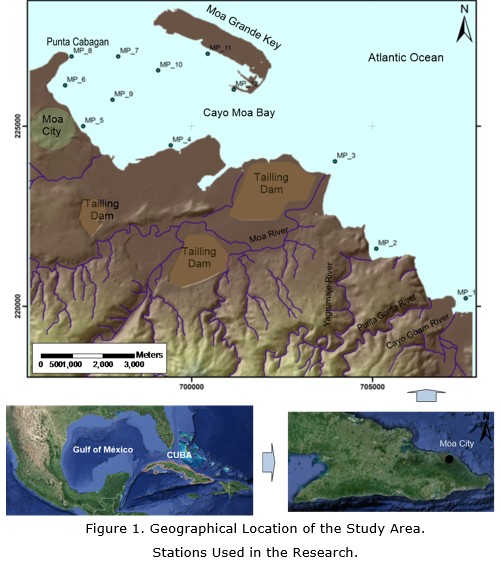
The studied area has a substrate formed by serpentinized ultrabasic rocks with a high degree of alteration, which was subjected to an intense tectonic activity. The degree of serpentinization in the region varies. Laterite soils lie on the serpentinized substrate, spatially located along the coast or near. Cr, Fe, Mn, Ni, Co, Cu, and Zn occur in various proportions in different profiles of the laterite soils.
At the bottom of the bay, friable quaternary clastic sediments and terrigenous biodentritical prevail. The lithology is represented by four horizons (from the bottom up): calcareous grit, carbonated sandy silt, carbonated silty and terrigenous silt (Menéndez 2001).
The stream pattern in the Moa Bay Cay is ruled by the effect of tides, showing a net water movement in the western direction during high tides and less intense in the east direction during low tides (Menéndez 2001). This implies that most waste and movement sediments carried over by the Cayo Guam, Punta Gorda, Yagrumaje and Moa rivers reach the bay and are being deposited along the coast.
2. MATERIALS AND METHODS
For geoaccumulation analysis, sediment samples were taken in three periods from 2009 through 2011. Twelve sampling locations were selected. These were sampled on a yearly basis for three consecutive years. Ten elements (Al, Cr, Fe, Mn, Ni, Co, As, Cu, Pb, and Zn) were determined. The average value will be used for subsequent calcullations.
Samples were collected by scuba diving. A collector tube inserted into the mud allowed 50 cm of sediment to be extracted. All samples were stored in a plastic bag of about one kilogram capacity.
The evaluated area was divided into two areas of work:
Deltaic zone: In this zone, the mouth of Moa, Yagrumaje, and Cayo Guam rivers were monitored. These are the main ways through which pollutants get into the marine area; therefore, the pollution of the area is caused by sediments recently accumulated in the delta. MP 1, MP 2 and MP 3 stations were located in the deltaic zone (Figure 1).
Industrial and urban, coastal zone: This includes the lagoon of the Moa Bay Cay that is bordered on the south by the coastline of Moa city and on the north by the southern coast of the Moa Grande Cay. It extends from Punta Cabagan in the west to Moa River in the east. Stations MP 5, MP 6, MP 7, MP 8 MP 9 MP 10, MP 11 and MP 12 where located in Moa Bay Cay (Figure 1).
The samples were dried at 60 °C for 24 hours and later sieved. The fraction ˂ 63 microns were extracted for analysis. A portion of dry sediment (0.5 g) was digested with the following mix of Suprapur® quality acid: 5 ml of HNO3 (concentrated), 10 ml of HF (concentrated) and 7 ml of HClO4 (concentrated) and evaporated to dryness. The residue was dissolved in 10 ml of HCl (concentrated) tranferred to a Teflon flask and adjusted to 25 ml with pure deionized water of 18.2 MΩcm-1. Determinations were carried out by using a Varian Vista MPX Axial ICP - AES spectrometer.
The accuracy of the analytical procedure used was checked by repeatedly analyzing reference samples (IAEA-365), and comparing the obtained values with the expected values. The quality control samples represented 10 % of the total analytical load. Precision was over 50 % and the results for the references samples were between 93 % and 105 % compared to the certified value.
The index value of geoaccumulation defined by Müller (1969) was used for assessing the contamination caused by sediments. This index has been used in several investigations and is proven to be a useful pollution geoindicator (Amat et al. 2002; Ong et al. 2013), (See Supporting Information SI.I).
The limits proposed by Long et al. (1995) were used (See Supporting Information SI.II) in order to interpret the information based on ecotoxicological criteria.
3. RESULTS AND DISCUSSIN
3.1. Sediment characterization
The color of the sediment obtained in the studied coastal area ranged between black and brown-red. The sediments most affected by suspended materials penetrating into the marine environment through Yagrumaje and Cayo Guam rivers are reddish, which is caused by laterite sediments.
However, sediments obtained from the delta of Moa River (MP 3) have a black coloration very similar to the tailings deposited near the mouth of the Moa Rive. This waste is carried over to the coast due to erosion during periods of heavy rains.
Granulometry, in most stations, shows the presence of clay or a mixture of clay with different types of sand (Table 1).
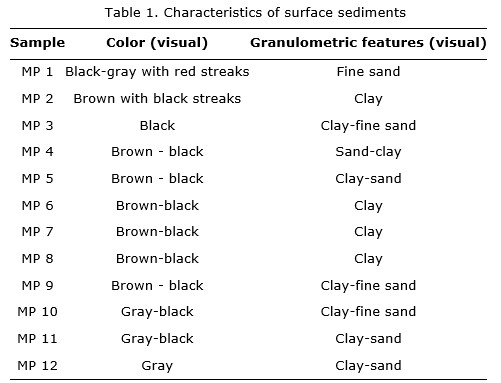
Factor analysis showed that the elements determined are in three groups: there is a high correlation between, Al, Cr, Ni and Fe (first group); a second group shows a high correlation between Mn, Co, Cu and Zn, and finally, a third group is formed by As and Pb (See Supporting Information SI.III).
3.2. Distribution of the elements studied
Aluminum
The area with the highest concentrations of Al covers the coastline from the west of Moa (MP 5) to the mouth of Cayo Guam River (MP 1) (Figure 2). At the MP 5 and MP 2 stations, concentrations above 80 mg g-1 were recorded. MP 5 is located in one of the areas receiving the largest quantities of sediments from the emerged areas and is situated on the southern shore of the Moa Bay Cay. Removal of silty sediments is high in this area, mainly caused by shallowness and the impact of climatic factors as well as dredging activity on the bay.
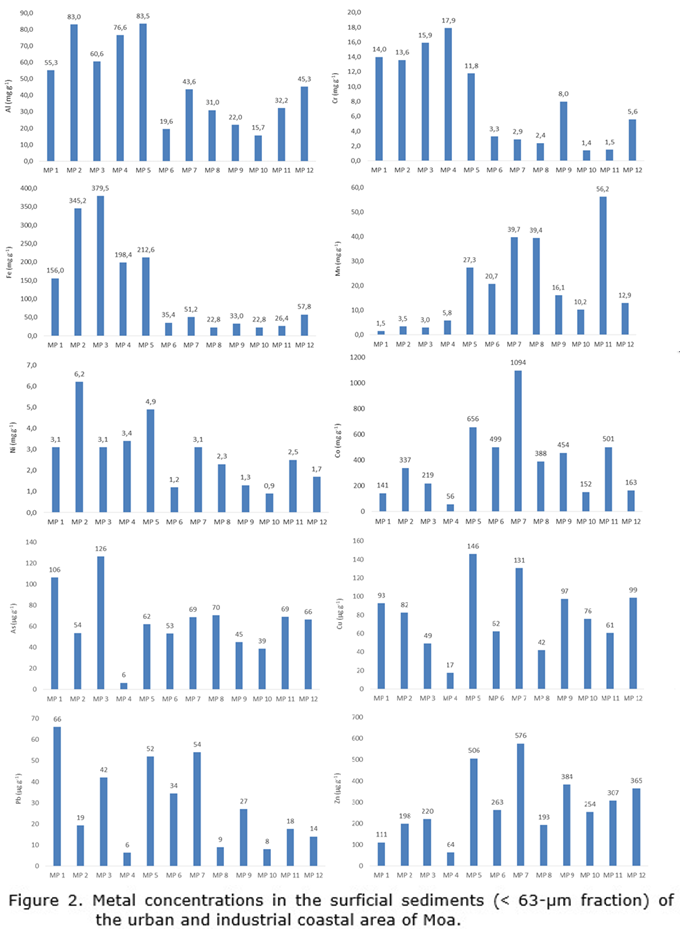
Figure 2. Metal concentrations in the surficial sediments (˂ 63-µm fraction) of the urban and industrial coastal area of Moa.
The delta of Yagrumaje River (MP 2) is an area where large volumes of eroded laterite sediments coming from various affected areas by the mining activity converge. Another reason explaining a high concentration of Al in this location is erosion of soil profiles in the presence of medium and low-grade bauxite in the northernmost section of the river (Bergues 2006). MP 3 and MP 4 are also close to the dumping area of liquid wastes coming from the industry with contents of Al between 4 000 and 5 000 mg /l (Cueto, Rondón y Fuentes 2003).
Chromium
Two zones that show differences in the chromium accumulation can be distinguished. The highest concentrations of Cr (1,18 to 17,9 mg g-1) are found in the coastal area from Moa city (MP 5) to the mouth of the river Cayo Guam (MP 1) and lower concentrations (1,4 to 5,6 mg g-1) are found to the west of Moa Bay Cay.
Chromium is a common element in the soils of the region; and the industrial wastes are another source of Cr going to the coast.
Iron
The studied region is one of the largest iron reserves around the world. Fe is concentrated in the tailings discharged by the existing mining industries which are stored behind dams located along the coast, for future use. In general, the concentration values are high. The concentrations of Fe exceed 150 mg g-1 in five stations. Maximum concentration values were found in MP 3 (379,5 mg g-1) and MP 2 (345,2 mg g-1) stations, located in the deltas of Moa and Yagrumaje rivers.
Lower contents were found to the northwest of the area, where the mayority of the monitored stations are located, except for MP 5 (212,6 mg g-1) and MP 4 (198,4 mg g-1). In the remaining stations, concentrations were all below 150 mg g-1 (Figure 2).
Manganese
Manganese is a metal associated to laterite soils and it is essentially found as oxides (MnO). In soil profiles, manganese oxides are phase mineral carriers of cobalt and nickel (Rojas, Rómulo y Orozco 2012). The highest concentration values were found in the industrial and urban coastal areas. The highest value is found in MP 11 (56,2 mg g-1). High concentration values of Mn are also found in MP 7 (39,7 mg g-1) and MP 8 (39,4 mg g-1). This is because the area of the lagoon is a basin receiving sediments, which carries Mn from the areas affected by erosion.
Nickel
Nickel is an essential element exploited by mining companies in the region. Its content in the ore ranges from 0,5 mg g-1 and 30 mg g-1 and the average in the surface sediments from the seabed is 2,8 mg g-1 (Figure 2). Maximum levels were found in MP 2 station (6,2 mg g-1) and MP 5 (4,9 mg g-1). Minimum contents were found in the lagoon, specifically in MP 10, MP 6 and MP 9 stations with values lower than 2 mg g-1.
The elements of Al, Cr, Fe and Ni show a similar accumulation pattern. Higher values are found in the deltaic zone (MP 1, MP 2 and MP 3) as well as in MP 4 and MP 5 stations located in the coastal zone. This behavior is due to these elements entering the coast by the Moa, Yagrumaje and Cayo Guam rivers and due to the ocean. Currents are carried over to the lagoon.
Cobalt
Cobalt is an element under exploitation by the local mining industry. Co occurs in laterite soils in smaller quantities than Ni. Its concentration in laterite profiles of the region ranges from 0,3 mg g-1 to 17,1 mg g-1. In urban and industrial coastal areas of Moa, the highest concentrations were found to the west of the lagoon. The highest values were found in MP 7 station with 1 094 µg g-1. Other significant values exceeding 500 µg g-1 were found in MP 5 and MP 11 stations. The lowest concentrations were found in stations MP 1, MP 4, MP 10 and MP 12 (Figure 2).
Arsenic
Arsenic is an element that has never been reported to be found in surface sediments on the coast of Moa. The concentrations found here range from 6 to 126 µg g-1 (Figure 2). The highest concentrations were found at the mouths of the Moa River (MP 3) with 126 µg g-1 and Cayo Guam River (MP 1) with 106 µg g-1; on the coastline of Moa the highest value was found in MP 8 and MP 11. The concentration decreases to the northwest of the lagoon.
Arsenic is an element dissociated from the local geology, which indicates that it reaches the bay because of human activity.
Copper
The concentration of Cu ranges from 17 to 146 µg g-1, with an average value of 79 µg g-1. The maximum values are distributed in the lagoon. The best examples are found in MP 5 (146 µg g-1) and MP 7 (130 µg g-1), and the highest values in the delta zone were associated with MP 1 (92 µg g-1) and MP 2 (82 µg g-1). As copper is not a common metal occurring in the laterite crust, its origin is presumed to be urban and mining - metallurgical activities in the coastline zone (Figure 2).
Lead
The concentration of lead ranges from 6 to 66 µg g-1. The highest concentrations are found in the mouth of Cayo Guam River (MP 1) and in the western portion of the Moa Bay Cay in MP 7 and MP 5 stations. Minimum values (below 10 µg g-1) were found in MP 4, MP 10 and MP 8 (Figure 2). There is no report of Pb being found in laterites so it is assumed that its origin is associated with the industrial and urban activity.
Zinc
Laterite soils contain large amounts of iron oxides, which are known to have strong zinc-binding capacity (Mandal et al. 1992). In surface marine sediments, the concentration ranges from 64 to 576 µg g-1, with an average value of 286 µg g-1 (Figure 2). The highest concentrations were found in the western portion of the Moa Bay Cay (MP 5, MP 7 and MP 9) and south of Moa Grande Cay in MP 12.
The accumulation of Zn, Cu and Co shows a pattern: the highest values are located in Moa Bay Cay specifically in MP 5 and MP 7 stations. The highest disposals of terrigenous sediments in this zone and the influence of dumping urban and industrial wastes on the coast is the major cause of this behavior.
Average, standard deviations and ranges for all samples analysed are in the supporting information (See Supporting Information SI. IV).
3.3. Geoaccumulation index
Calculation results of the geoaccumulation index are shown in Table 2. According to the ranges established by Müller (1969) for the evaluation, the analysis reveals significant pollution values for Al, Cr, Fe, Ni and Zn in each station.
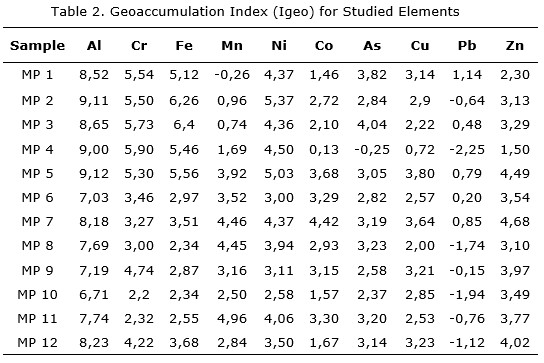
A significant pollution in surface sediments in the entire region is observed by calculating the Igeo. Al is the element of greader accumulation in samples with a maximum Igeo value of 9,12 (MP 5) and a minimum value of 6,71 (MP 10). Cr, Fe and Ni are also metals with a high geoaccumulation. In general, the most contaminatedsamples were found in MP 5, MP 7, MP 2 and MP 3, indicating a significant level of pollution throughout the analyzed coastal sector.
The Mn geoaccumulation was not significant in the delta zone; however, the values increase within the lagoon and reach a maximun value in the MP 11 station. Co, As and Cu are observed as recurrent contaminants in all stations, except in MP 4.
Of all analyzed elements, Pb had the lowest geoaccumulation because only a low degree of contamination was observed in MP 1. Negative Igeo values for Mn, As and Pb in some stations indicate that the sediments are not contaminated by these metals.
3.4. Data interpretation based on ecotoxicological criteria
According to the comparison between the obtained concentrations and the ecotoxicological criteria proposed by Long et al. 1995, the impact of pollution in the studied area is shown in Table 3.
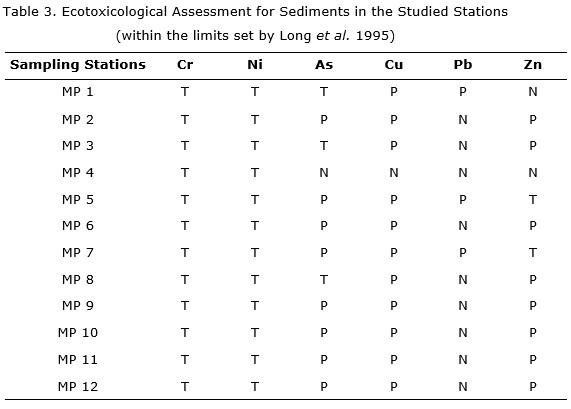
T: Toxic environment; P: Polluted environment; N: Nontoxic (see explanation in the supporting information SI.II)
Potentially toxic levels characterize all samples, whereas the concentrations of Cr, Ni, As, Cu, Pb, and Zn in the deltaic and coastal zone sediments express a risk for the biota. The MP 5 and MP 7 stations appear to pose the highest potential biological risk throughout the coastal zone because all the elements analyzed show a potential toxicity. All samples from the deltaic zone are toxic for Cr, Ni, As and Cu. The MP 1 is potentially toxic for Pb and two samples for Zn (stations MP 2 and MP 3).
4. CONCLUSIONS
· Surface sediments from the Moa Bay Cay are characterized by having concentrations of elements that are typical of aquatic environments located in industrial and densely populated areas. This largely reflects a relation with major impact sources, which explains the role of local industrial activities in chemically altering the quality of sediments.
· According to the Geo-accumulation Index calculated for the elements, the degree of pollution ranged from unpolluted to very strongly polluted. The results revealed the following tendencies in their order of geo-accumulation in the sediments: Pb < Mn < Co < Cu < As < Zn < N i< Fe < Cr <Al. The Igeo for Al was the highest value while it was the lowest value for Pb. The ecotoxicological risks of sediments in Moa Bay Cay is very high, and more than 80 % of the samples pose a toxic risk for marine environments and its development.
· Even though there is no area that can be classified to be unpolluted based on the calculated Igeo, four stations MP 5 and MP 7 in the coastal zone and MP 3 and MP 2 in the deltaic zone have been identified as critical locations of contamination. The levels of Cr, Ni, Co, As and Cu shall be strictly monitored in the future because they appear to be associated with a potential biological risk.
· This research clearly highlights the pressing need to make great efforts to control industrial disposals in the coastal area. It also indicates that immediate measures are to be taken to minimize contamination and to prevent future pollution issues.
· The investigation results have been considered in the definition of a specific set of geoindicators for assessing and monitoring the condition of the coastal environment and can be of great help for developing an Integrated Coastal Zone Management.
5. ACKNOWLEDGMENTS
The financial support from the Technical University of Clausthal, VLIR-UOS, and the Program of Belgian Cooperation for the Development is highly appreciated. We would also like to take this opportunity to express our gratitude to the anonymous reviewers for their insightful comments.
6. REFERENCES
Amat, D.; Pierra, A.; Casals, I. y Vázquez, D. 2002: Estudio de la contaminación por metales pesados en sedimentos y ostiones de la bahía de Manzanillo, Cuba. Journal of the Mexican Chemical Society 46(4): 357-361.
Bergues, P. 2006: Presencia de perfiles lateríticos con intercalaciones atípicas y bauxitas en el sector septentrional del río Yagrumaje, Moa. Minería y Geología 22(1): 1-8.
Cervantes, Y.; Almaguer, Y.; Pierra, A.; Orozco, G. y Gursky, H. 2011: Metales traza en sedimentos de la bahía de Cayo Moa (Cuba): evaluación preliminar de la contaminación. Minería y Geología 27(4): 1-19.
Cesigma.1997: Report on complete oceanographic study of the reef lagoon of Cayo Moa Bay. Prepared by CESIGMA – División América and GENECAR S.A., Report, 105 p. Unpublished.
Cueto, F.; Rondón, E. y Fuentes, R. 2003: Efluente líquido (wl) de la tecnología de lixiviación ácida: alternativas de tratamiento. Minería y Geología 19(3-4): 79–84.
Fernández, Z.2009: Plan de MIZC para minimizar el azolvamiento en la bahía de Cayo Moa. Master Thesis. Universidad de Oriente. Santiago de Cuba, Cuba. 106 p.
Gang, X.; Jian, L.; Shaofeng, P.; Gang, H. y Xianghuai, K. 2016: Sources and geochemical background of potentially toxic metals in surface sediments from the Zhejiang coastal mud area of the East China Sea. Journal of Geochemical Exploration 168: 26-35.
Gupta, S.; Jena, V.; Matic, N.; Kapralova, V. y Solanki, J. 2014: Assessment of geo-accumulation index of heavy metal and source of contamination by multivariate factor analysis. International Journal of Hazardous Materials 2(2): 18-22.
Herrera, J; Rodríguez, J; Coto, J; Salgado, V y Borbón, H. 2013: Evaluación de metales pesados en los sedimentos superficiales del río Pirro. Tecnología en Marcha 26(1): 27-36.
Long, E.; Macdonald, D.; Smith, S. y Calder, F. 1995: Incidence of adverse biological effects within ranges of chemical concentrations in marine and estuarine sediments. Environmental Management 19(1): 81-97.
Mandal, B.; Chatterjee, J.; Hazra, G. y Mandal, L. 1992: Effect of preflooding on transformation of applied zinc and its uptake by rice in lateritic soils. Soil Science 153(3): 250-257.
Menéndez, M. 2001: Explotación racional del yacimiento de Cienos Carbonatados en la Bahía de Cayo Moa. Guardado, R. (Tutor). Master Thesis. Instituto Superior Minero Metalúrgico de Moa, Cuba. 78 p.
Müller, G.1969: Index of geoaccumulation in sediments of the Rhine River. Geology Journal 2(3): 108–118.
ONEI. 2014: Anuario estadístico de Moa 2013. Report, Moa, Cuba. Unpublished.
Ong, M.; Menier, D.; Shazili, N. y Kamaruzzaman, B. 2013: Geochemical Characteristics of Heavy Metals Concentration in Sediments of Quiberon Bay Waters, South Brittany, France. Oriental Journal of Chemistry 29(1): 39-45.
Rojas, A.; Rómulo, S. y Orozco, G. 2012: Identificación mineralógica de los óxidos de manganeso del yacimiento laterítico Punta Gorda, Moa, Cuba. Minería y Geología 28(1): 1-26.
Zhu, H.; Zeng, G.; Jiang, M.; Liang, J.; Zhang, C.; Yin, J.; Huang, H.; Liu, Z. y Jiang, H. 2012: Ecological risk assessment of heavy metals in sediments of Xiawan Port based on modified potential ecological risk index. Trans. Nonferrous Met. Soc. China 22: 1470-1477.
7. Supporting information I
SI. 1- Assessing the degree of pollution
The index value of geoaccumulation defined by Müller (1969) and used in several researches because of its importance as geoindicator of pollution (Amat et al. 2002; ONG et al. 2013) was used to assess sediment contamination.
The geoaccumulation index is defined by:
Igeo = log 2 (Cn / 1.5 Bn)
Where:
Cn = concentration of metal;
Bn = geochemical background value.
A company specialized in geographic and environmental solutions – CESIGMA - (1997) established the background values for Moa Bay Cay. They used as a reference by the same consultant in 2002 (Table 1).

*(Salomons y Förstener (1984))
In the case of arsenic the background value has not been identified in previous studies, so the value given as a world average in shallow water sediment, by Salomons y Förstener (1984), is reported.
According to Müller (1969), the value of Igeo allows to classify sediments according to the degree of pollution, as shown in Table 2.
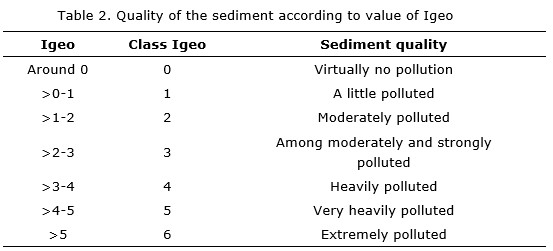
Source: Müller (1969)
References
Amat, D.; Pierra, A.; Casals, I. y Vázquez, D. 2002: Estudio de la contaminación por metales pesados en sedimentos y ostiones de la bahía de Manzanillo, Cuba. Journal of the Mexican Chemical Society46(4): 357-361.
Cesigma. 1997: Report on complete oceanographic study of the reef lagoon of Cayo Moa Bay. Prepared by CESIGMA – División América and GENECAR S.A., Report, 105 p. Unpublished.
Müller, G. 1969: Index of geoaccumulation in sediments of the Rhine River. Geology Journal 2(3): 108–118.
Ong, M.; Menier, D.; Shazili, N. y Kamaruzzaman, B. 2013: Geochemical Characteristics of Heavy Metals Concentration in Sediments of Quiberon Bay Waters, South Brittany, France. Oriental Journal of Chemistry 29(1): 39-45.
Salomons, W. y Förstner, U. 1984: Metals in the Hydrocycle. Springer-Verlag, Berlin, Germany. 352 p. ISBN: 978-3642693274.
8. Supporting information II
SI. II - Data analysis based on quality criteria
In order to interpret the information based on ecotoxicological criteria the limits proposed by Long et al. (1995) were used. Two reference values for the concentration of metals in sediment are considered: the lowest concentration that may have adverse effects on living beings (ERL) and the maximum tolerable level (ERM). Concentrations exceeding the latter values are considered very toxic (Accornero, Gnerre y Manfra 2008).
According to Long et al. (1995):
· If the metal concentration is below ERL, contamination is not significant.
· If the concentration of the metal exceeds ERL, but is below ERM, environment is polluted.
· If the concentration exceeds ERM, the environment is toxic.
These researchers identified and studied the effects on organisms and ecosystems of the accumulation of nine elements (As, Cr, Cd, Pb, Cu, Ni, Zn, Hg, and Ag) and their criteria have been widely accepted and based on studies conducted by the Environmental Protection Agency of the USA (USEPA) and by Accornero, Gnerre y Manfra (2008). Table 3 shows the limits for ecotoxicological assessment for As, Cr, Cu, Pb, Ni and Zn proposed by Long et al. (1995) for surface sediment.
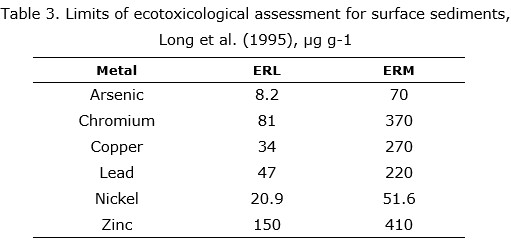
References
Accornero, A.; Gnerre, R. y Manfra, L. 2008: Sediment concentrations of trace metals in the Berre Lagoon (France): An assessment of contamination. Archives of Environmental Contamination and Toxicology 54(3): 372-385.
Long, E.; Macdonald, D.; Smith, S. y Calder, f. 1995: Incidence of adverse biological effects within ranges of chemical concentrations in marine and estuarine sediments. Environmental Management 19(1): 81-97.
9. Supporting information III
SI. III - Factorial analysis (Use SPSS STATISTICS software)
FACTOR
/VARIABLES Al Cr Fe Mn Ni Co As Cu Pb Zn
/MISSING LISTWISE
/ANALYSIS Al Cr Fe Mn Ni Co As Cu Pb Zn
/PRINT UNIVARIATE INITIAL CORRELATION SIG DET KMO INV REPR AIC EXTRACTION ROTATION FSCORE
/FORMAT SORT
/CRITERIA MINEIGEN (1) ITERATE (25)
/EXTRACTION PC
/CRITERIA ITERATE (25)
/ROTATION VARIMAX
/METHOD=CORRELATION.
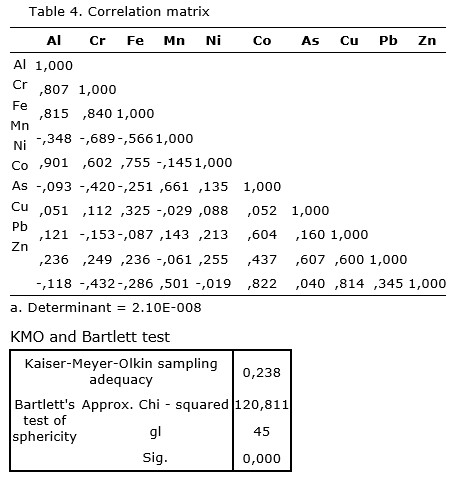
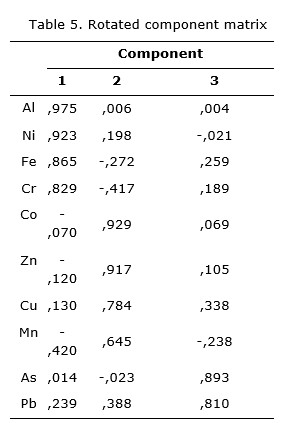
Extraction method: Principal component analysis.
Rotation method: Varimax with Kaiser normalization.
10. Supporting information IV
SI. IV - Average, standard deviation and ranges of values for the elements studied

Recibido: 09/03/2017
Aprobado: 08/04/2017
Yosbanis Cervantes Guerra, Higher Mining and Metallurgist Institute of Moa, Cuba ycervantes@ismm.edu.cu














